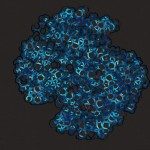Link to Pubmed [PMID] – 1913806
Cell 1991 Sep;66(6):1185-95
The cAMP receptor protein (CRP) and MaIT, the maltose regulon activator, synergistically activate transcription from the E. coli maIKp promoter. The maIKp regulatory region comprises two series of MaIT-binding sites separated by three CRP-binding sites. By combining genetic and biochemical studies, we demonstrate that the promoter-proximal region contains two overlapping sets of three MaIT-binding sites. Occupation of the higher affinity set of sites, which occurs in the absence of CRP, does not lead to malKp activation. In contrast, in the presence of CRP, MalT binds to the lower affinity set of sites and triggers transcription initiation because, unlike the high affinity set, the low affinity set of sites is properly positioned with respect to the Pribnow box. The CRP effect requires the malKp-distal MalT-binding sites. The synergistic action of MalT and CRP therefore relies on MalT repositioning via the formation of a nucleoprotein structure involving the entire regulatory region.

